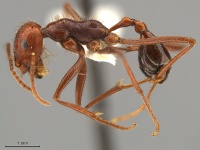Ocymyrmex celer
| Ocymyrmex celer | |
|---|---|

| |
| Scientific classification | |
| Kingdom: | Animalia |
| Phylum: | Arthropoda |
| Class: | Insecta |
| Order: | Hymenoptera |
| Family: | Formicidae |
| Subfamily: | Myrmicinae |
| Tribe: | Crematogastrini |
| Genus: | Ocymyrmex |
| Species: | O. celer |
| Binomial name | |
| Ocymyrmex celer Weber, 1943 | |
Nothing is known about the biology of Ocymyrmex celer.
Identification
Bolton (1981) - Along with Ocymyrmex nitidulus this species can be separated from all others in which the clypeus is impressed and the first gastral segment constricted by the slick and glossy appearance of the head. In all others the ground-sculpture on the head consists of quite conspicuous granulation or punctulation, but in celer and nitidulus this is very reduced or absent, leaving the spaces between costulae smooth or very nearly so, and shining. The two may be distinguished by the shape of the pronotum, which in nitidulus is convex and, together with the mesonotum, forms an evenly convex surface. In celer the pronotum is flat and an even convexity does not result.
Keys including this Species
Distribution
Distribution based on Regional Taxon Lists
Afrotropical Region: Sudan (type locality).
Distribution based on AntMaps
Distribution based on AntWeb specimens
Check data from AntWeb
Countries Occupied
| Number of countries occupied by this species based on AntWiki Regional Taxon Lists. In general, fewer countries occupied indicates a narrower range, while more countries indicates a more widespread species. |

|
Estimated Abundance
| Relative abundance based on number of AntMaps records per species (this species within the purple bar). Fewer records (to the left) indicates a less abundant/encountered species while more records (to the right) indicates more abundant/encountered species. |

|
Biology
|
Castes
Known from workers and queens.
Nomenclature
The following information is derived from Barry Bolton's Online Catalogue of the Ants of the World.
- celer. Ocymyrmex weitzeckeri subsp. celer Weber, 1943c: 368 (w.) SUDAN. Bolton & Marsh, 1989: 1278 (q.). Raised to species: Bolton, 1981b: 267.
Unless otherwise noted the text for the remainder of this section is reported from the publication that includes the original description.
Description
Worker
Bolton (1981) - TL 8.1-8.5, HL 1.98-2.04, HW 1.82-1.88, CI 91-94, SL 1.68-1.73, SI 89-95, PW 1.12-1.16, AL 2.30-2.46 (4 measured).
Anterior clypeal margin with a conspicuous median impression which is flanked on each side by a low broad tooth. Sides of head in front of eyes more or less parallel in full-face view, not obviously diverging anteriorly as is frequent in the genus. Maximum diameter of eye 0.38-0.39, about 0.21 x HW. Dorsum of pronotum in profile flat to indented, sloping upwards behind to its junction with the mesonotum; the promesonotum not forming a single even convexity. Dorsum of propodeum rounding broadly and evenly into the sloping declivity. Metapleural lobes deep but narrow, rounded and little projecting. Petiole node in profile small, low and rounded, in dorsal view longer than broad. Postpetiole in dorsal view slightly longer than broad. First gastral tergite with a neck-like constriction basally. Dorsum of head finely densely and regularly longitudinally costulate, the costulae low and superficial, weakly developed, parallel and arching outwards behind the eyes. Spaces between the costulae highly polished, without strong granular or punctulate ground-sculpture; the whole head with a slick and glossy appearance. Pronotum with weak to feeble arched-transverse costulate sculpture dorsally, which may be almost effaced centrally, the space between the mesothoracic spiracles with longitudinal or transverse costulate sculpture. Remainder of dorsal alitrunk transversely and more strongly costulate. Sides of alitrunk regularly densely sharply costulate everywhere. Petiole node with transverse rugulae ventrally which may extend for some distance up the sides, and with faint rugulae on the dorsal peduncle, but the dorsum of the node unsculptured or only with the faintest vestiges present. Postpetiole only with superficial patterning. All dorsal surfaces of head and alitrunk with numerous hairs of varying length; first gastral tergite with hairs shorter and much sparser than on alitrunk. Colour glossy dull red, the gaster dark brown.
Type Material
Bolton (1981) - Syntype workers, Sudan: Torit, N. oflmatong Mts, 6.viii.l939, no. 1462 (N. A. Weber) (Museum of Comparative Zoology) [examined].
References
- Bolton, B. 1981. A revision of six minor genera of Myrmicinae (Hymenoptera: Formicidae) in the Ethiopian zoogeographical region. Bulletin of the British Museum (Natural History) Entomology. 43:245-307. (page 267, Raised to species)
- Bolton, B. and A. C. Marsh. 1989. The Afrotropical thermophilic ant genus Ocymyrmex (Hymenoptera: Formicidae). Journal of Natural History. 23:1267-1308. (page 1278, queen described)
- Weber, N. A. 1943d. The ants of the Imatong Mountains, Anglo-Egyptian Sudan. Bulletin of the Museum of Comparative Zoology 93: 263-389. (page 368, worker described)
References based on Global Ant Biodiversity Informatics
- Bolton B. 1981. A revision of six minor genera of Myrmicinae (Hymenoptera: Formicidae) in the Ethiopian zoogeographical region. Bulletin of the British Museum (Natural History). Entomology 43: 245-307.
- Bolton B., and A. C. Marsh. 1989. The Afrotropical thermophilic ant genus Ocymyrmex (Hymenoptera: Formicidae). Journal of Natural History 23: 1267-1308.
- Garcia F.H., Wiesel E. and Fischer G. 2013.The Ants of Kenya (Hymenoptera: Formicidae)Faunal Overview, First Species Checklist, Bibliography, Accounts for All Genera, and Discussion on Taxonomy and Zoogeography. Journal of East African Natural History, 101(2): 127-222
- Weber N. A. 1943. The ants of the Imatong Mountains, Anglo-Egyptian Sudan. Bulletin of the Museum of Comparative Zoology 93: 263-389.

